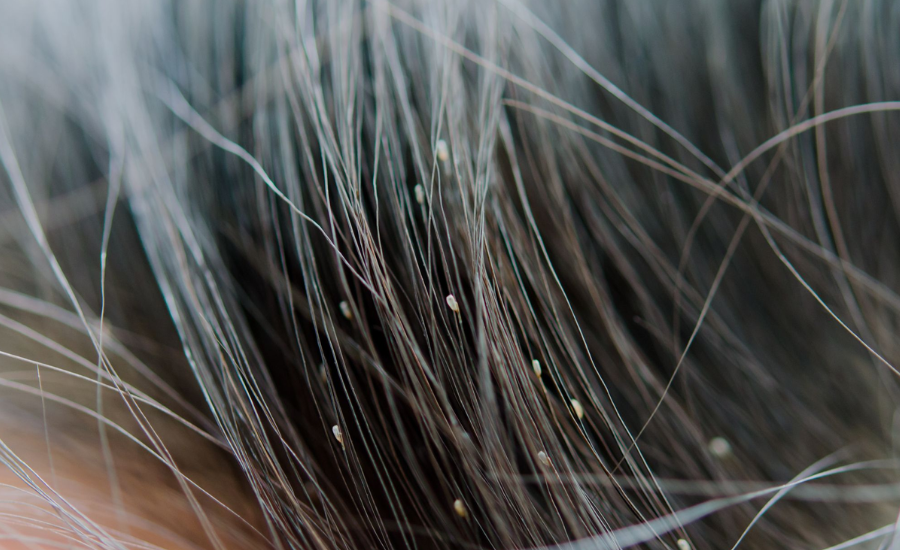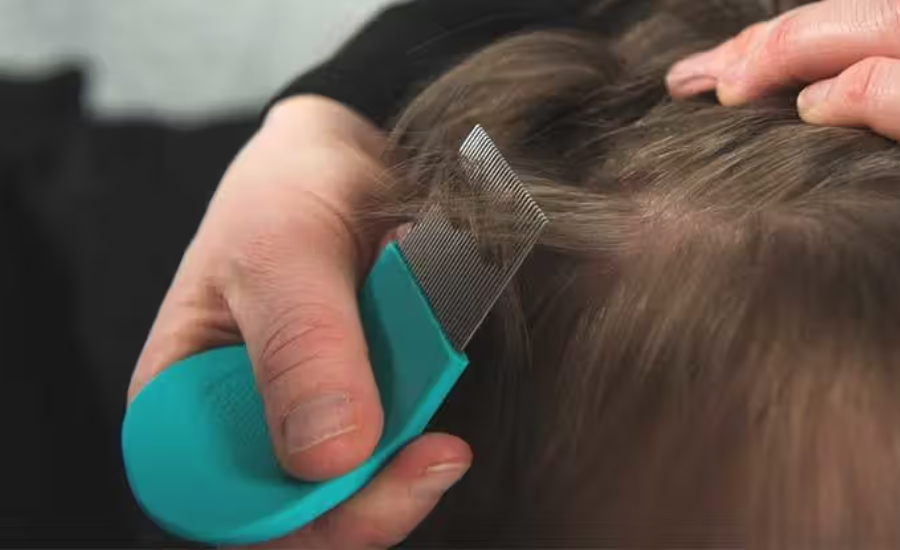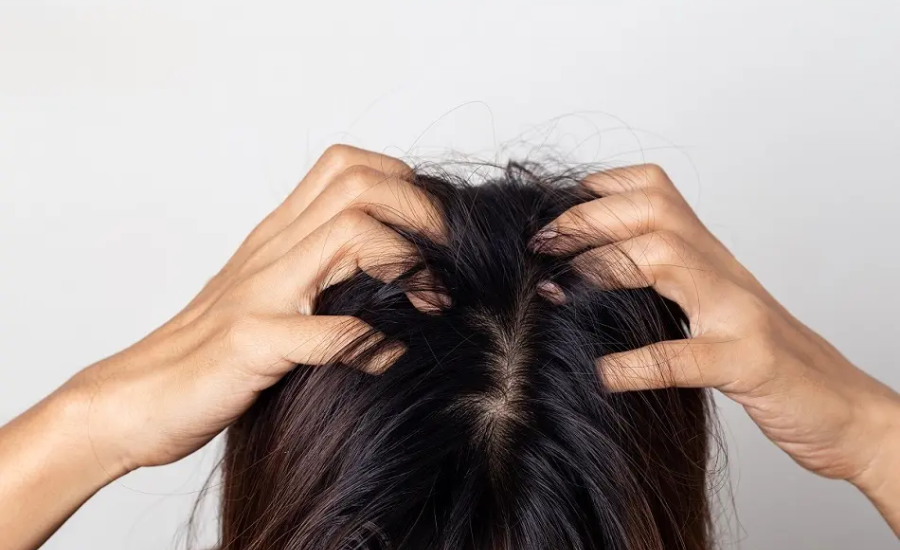Have you ever felt an itch and immediately started worrying that you might have lice? It’s natural to feel a bit paranoid in such situations, but there are simple ways to figure out whether you’re truly dealing with a lice problem. By familiarizing yourself with the typical signs of a lice infestation and learning how to properly check for them, you can put your mind at ease and take the right steps if necessary.
What Are Lice?

Lice are small parasitic insects that rely on human blood to survive. Three types of lice infest humans: head lice, which are the most common and primarily live on the scalp; body lice, which inhabit clothing but move to the skin to feed; and pubic lice, also known as “crabs,” which usually infest the genital area but can also be found in coarse body hair such as that of the beard, eyebrows, or eyelashes.
The life cycle of lice involves three distinct stages, each playing a critical role in their development and infestation:
- Nit (Egg):
- Nits are the eggs laid by adult lice. They are oval-shaped and can range in color from yellow to white.
- Extremely small, they measure around 0.8 to 0.3 millimeters, roughly the size of a grain of sand.
- Nits are typically found attached to the base of hair strands, close to the scalp, as they need warmth to develop.
- It takes around 9 to 10 days for nits to hatch into nymphs.
- Nymph:
- After hatching, the lice emerge as nymphs, which are essentially immature lice.
- Nymphs are yellowish in color and extremely tiny, about the size of a pinhead.
- They remain close to the hair shaft as they continue to grow.
- Within about 7 days, nymphs mature into adult lice.
- Adult Lice:
- Fully developed adult lice are about the size of a sesame seed, with six legs that allow them to cling to hair.
- They vary in color from gray to white.
- Adult lice can live for up to 30 days on a human host, feeding on blood to survive.
- Female lice are larger than males and are capable of laying up to 8 eggs (nits) per day, contributing to the rapid spread of infestations.
Head Lice
Among the three types of lice, head lice are the most commonly known and talked about. These lice primarily spread through direct contact, such as when heads touch, making it easy for them to crawl from one person to another. However, they can also be transferred through shared personal items like hats, combs, or hairbrushes. Because head lice rely on human blood for survival, anyone can get them, regardless of hygiene or cleanliness. While both adults and children are at risk, children are particularly vulnerable because of frequent close contact with others during activities like playing, sports, or school interactions.
Symptoms Of Head Lice:
If you’re worried about head lice, here are some of the most common signs to watch for:
- Persistent Itching: One of the most noticeable symptoms, caused by an allergic reaction to the lice bites.
- Tickling Sensation: Some people report a crawling or tickling feeling in their hair.
- Difficulty Sleeping: Since lice tend to be more active at night, this can lead to discomfort and trouble sleeping.
- Scratching Sores: Continuous scratching can lead to open sores, which may become infected if not treated properly.
Body Lice
Body lice, also known as “clothes lice,” differ from head lice in that they are primarily found in clothing rather than on the body. However, they will move onto the skin to feed on human blood, which is essential for their survival. People living in conditions where hygiene is difficult to maintain, such as those experiencing homelessness or residing in overcrowded environments, are more vulnerable to body lice infestations. Since these lice thrive in dirty clothing and bedding, individuals who do not have regular access to showers or laundry facilities are at higher risk. Unlike head lice, body lice can also carry and transmit serious diseases, such as typhus and trench fever, making them a significant health concern in poor living conditions.
Symptoms Of Body Lice:
The signs of a body lice infestation often resemble those of head lice, particularly in terms of itching, but there are some additional symptoms to look for:
- Severe Itching: Persistent and intense itching, caused by the lice feeding on the skin.
- Rashes: Red, irritated skin may develop in areas where the lice have bitten repeatedly.
- Infected Sores: Continuous scratching can lead to sores that may become infected if not treated.
- Thickened and Discolored Skin: Over time, areas that are repeatedly bitten, particularly around the waist, groin, and armpits, can become thicker, leathery, and discolored, indicating a prolonged infestation.
Pubic Lice
Pubic lice, commonly referred to as “crabs” due to their claw-like appearance and body shape, are a specific type of lice that infest the genital region. While they predominantly live in the coarse hair found in this area, they can also reside in other areas with thicker hair, such as the beard, chest, armpits, eyebrows, and even eyelashes. These lice are primarily spread through sexual contact, but they can occasionally be transmitted through other forms of close physical contact or by sharing personal items like clothing, bedding, or towels.
One of the key differences between pubic lice and other types of lice is that pubic lice do not carry or transmit diseases. However, because they are often spread through sexual contact, the Centers for Disease Control and Prevention (CDC) advises that anyone diagnosed with pubic lice be evaluated for sexually transmitted diseases (STDs) as a precaution.
Symptoms Of Pubic Lice:
- Intense Genital Itching: This is the most common symptom and is caused by the lice feeding on the blood in the affected area.
- Rashes: Continuous scratching in response to itching can lead to irritated, red skin and rashes in the genital area.
- Secondary Infections: Scratching can sometimes cause sores or breaks in the skin, which may become infected by bacteria if not properly treated.
- Blue or Dark Bite Marks: Small bluish or dark spots may appear near the groin or lower abdomen, which are a result of the lice bites.
Despite the discomfort they cause, pubic lice are relatively easy to treat with over-the-counter lotions or prescription medications. Proper hygiene and treating items that may have come into contact with the lice, such as bedding and towels, can prevent re-infestation.
What Can Lice Be Mistaken For?
While itching is one of the most common early signs of a lice infestation, it alone cannot confirm the presence of these parasites. Several other conditions can cause similar symptoms and are often mistaken for lice.
Dandruff
The Dandruff, a common scalp condition, often causes itching and is frequently confused with lice. Dandruff consists of small, dry flakes of skin that are easy to brush off the scalp. Unlike nits (lice eggs), which are firmly attached to the hair shaft and require a special comb for removal, dandruff flakes are loose and move easily. People often misidentify these flakes as nits because of their appearance, but dandruff is much more superficial and easy to treat with proper scalp care.
Hair And Laundry Products
Residue from hair care products, such as shampoos, conditioners, and styling agents, can also be mistaken for lice. If hair products are not properly rinsed out, or if they are left in the hair overnight, they can cause itching and irritation on the scalp. This buildup can sometimes resemble the debris left by lice. Additionally, some people may experience contact dermatitis, a reaction in which new products cause itching, redness, or rashes.
Skin Conditions
Various skin conditions, including eczema and scalp psoriasis, are also frequently misdiagnosed as lice infestations. These conditions can cause persistent itching, flaking, and red patches that mimic the symptoms of lice. In cases of eczema, the skin becomes dry, inflamed, and irritated, leading to itchiness similar to that caused by lice. Scalp psoriasis, on the other hand, results in thicker, scaly patches of skin that may appear as raised, red areas.
How Are Lice Diagnosed?

To accurately determine if you have lice, a careful inspection of the hair and scalp is essential. Confirming the presence of lice or their eggs (nits) is the only way to be certain. For body lice, a thorough check of the seams of your clothing or a close examination of the skin may reveal the parasites or their eggs. Pubic lice, although slower than head lice, attach firmly to strands of coarse hair, making them more difficult to spot.
When inspecting for lice, it’s crucial to use a strong light source, such as a bright lamp or natural sunlight. A magnifying glass can also be helpful, especially for individuals with dark hair where lice and nits may be harder to detect. To aid in your search, use a fine-tooth comb and work through the hair in small sections, ensuring a thorough inspection. Focus on areas where lice are most likely to hide—close to the scalp, particularly behind the ears and at the nape of the neck.
It’s important to note that dandruff, hair product residue, or other debris can be mistaken for nits. However, dandruff and product build-up are typically loose and easy to remove from the hair. Nits, in contrast, are firmly attached to the hair shaft and require a special lice comb to dislodge them. By taking the time to carefully inspect the scalp, you can differentiate between lice and other scalp irritants.
Treatment Options For Lice
When dealing with lice infestations, several effective treatment options are available. One of the most widely used methods involves over-the-counter medicated shampoos that contain active ingredients such as permethrin or pyrethrin. These shampoos are designed to be applied directly to the hair and scalp, left on for a specified period, and then rinsed out thoroughly.
For more severe cases, prescription-strength treatments may be necessary. These stronger formulations often contain potent chemicals like malathion or benzyl alcohol and are available through a healthcare provider. After the initial treatment, it’s essential to monitor for any remaining lice or nits by inspecting the scalp every 2 to 3 days. Continue this vigilant checking for about 2 to 3 weeks to ensure that both lice and their eggs are completely eradicated. Some treatment protocols may recommend a second application after nine days, so it’s important to follow the instructions provided on the medication carefully.
Additionally, it’s crucial to treat all family members or close contacts to prevent re-infestation. Cleaning any bedding, clothing, or personal items that may have come into contact with lice is also vital. For items that cannot be washed, sealing them in a plastic bag for up to two weeks can help ensure that any lingering lice are eliminated. Taking these comprehensive steps will aid in effectively resolving a lice infestation and preventing it from returning.
What If Treatment Fails?

Several factors can contribute to the failure of lice treatment. One possible reason is misdiagnosis; it’s possible that there was never an active lice infestation to begin with. Additionally, mistakes in administering the medication, resistance of lice to the treatment used, or a subsequent re-infestation can hinder successful outcomes.
Fortunately, there are multiple treatment options available for managing lice infestations. If you find that your initial treatment efforts have not worked, seeking help from a board-certified dermatologist can be invaluable. A dermatologist can assess the steps you’ve already taken, identify any potential issues, and recommend a more effective course of action tailored to your situation.
Dealing with lice can be both distressing and frustrating for individuals and families. Understanding how to recognize the signs of lice and accurately diagnosing the problem is crucial. By educating yourself about the symptoms and the proper treatments, you can take effective measures to eliminate lice and prevent future infestations. Knowledge is your best ally in tackling this pesky problem.
FAQs About Lice
- What are the common types of lice?
The three main types of lice are head lice (found on the scalp), body lice (living in clothing but feeding on the skin), and pubic lice (infesting the genital area).
- How do lice spread?
Lice spread primarily through direct contact with an infected person or by sharing personal items such as hats, combs, clothes, or bedding. Pubic lice are mostly transmitted through sexual contact.
- What are the symptoms of lice?
Common symptoms include intense itching, a tickling sensation on the scalp or skin, difficulty sleeping (as lice are more active at night), and potential rashes or sores from scratching. For pubic lice, you may notice blue or dark bite marks in the groin area.
- How can I differentiate between lice and dandruff?
Dandruff consists of loose flakes that can be easily brushed off, while lice nits are firmly attached to the hair shaft and require a fine-tooth comb for removal. Lice also produce a tickling sensation, unlike dandruff, which mainly causes itching.
- How are lice treated?
Treatment typically involves over-the-counter medicated shampoos or stronger prescription options. Follow the application instructions carefully, and check for lice or nits every 2-3 days after treatment. Wash any bedding or clothing that may have been contaminated.
- What should I do if lice treatment fails?
If treatment is unsuccessful, it could be due to misdiagnosis, improper use of medication, or resistant lice. In such cases, consult a dermatologist for further advice.
- How can I prevent re-infestation?
After treatment, thoroughly clean all bedding, clothing, and personal items that may have come into contact with lice. For items that cannot be washed, seal them in a plastic bag for two weeks. Ensure that all close contacts and family members are treated to prevent re-infestation.
Conclusion
Lice infestations may not pose a serious health risk, but they can be quite uncomfortable and stressful due to the severe itching they cause. To effectively identify and treat lice, it’s important to understand the different types, their modes of transmission, and their symptoms. Conducting regular inspections, applying appropriate treatment methods, and thoroughly cleaning any items that may be infested are essential steps for successful eradication. If over-the-counter treatments do not work, consulting a dermatologist is advisable for alternative solutions and strategies to prevent re-infestation. With the right approach, you can effectively manage and eliminate lice.
Get the latest alerts and updates directly: Pudelek!
